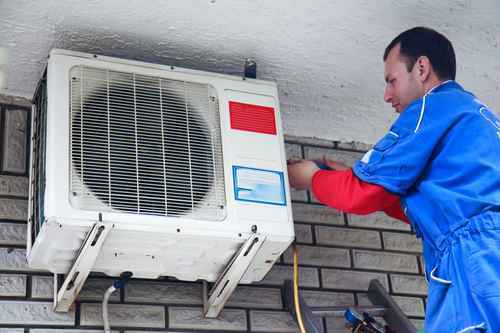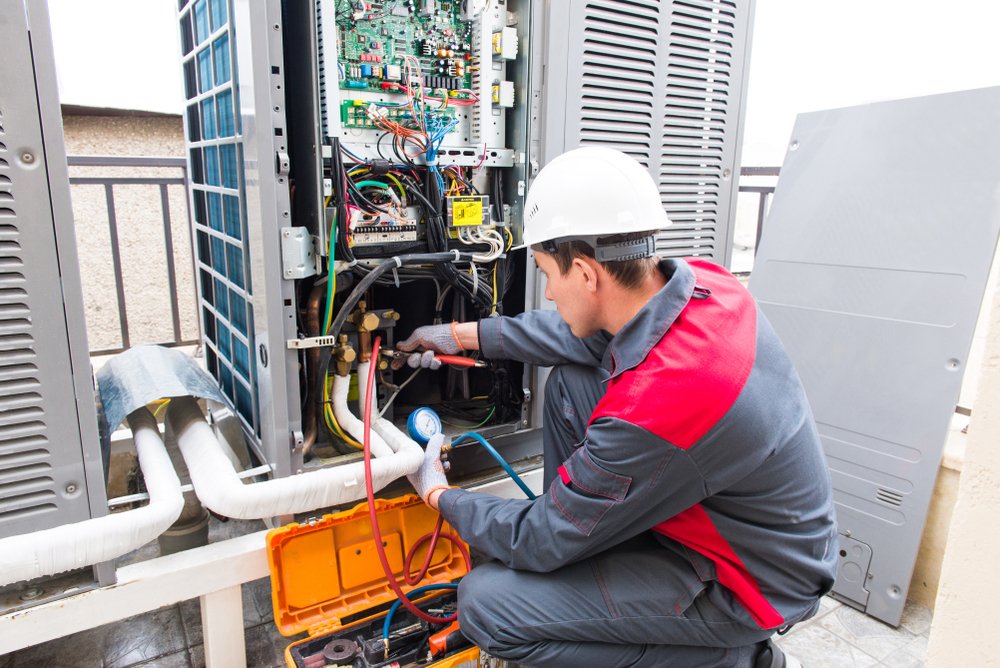Have you ever questioned why cooling setup in high-rise buildings offers one-of-a-kind obstacles?
The intricacy goes beyond just cooling the rooms efficiently. From steering restricted area restrictions to resolving vertical distribution challenges, each element calls for thorough preparation.
However what concerning the architectural factors to consider and ensuring ease of access to electrical power for these systems?
These are just a few items of the challenge that make taking on air conditioning installation in high-rise buildings a multifaceted venture.
Key Takeaways

- Calculated equipment placement and sound control are essential in skyscraper AC installations.
- Effective ductwork transmitting and upkeep gain access to make certain optimum cooling and heating performance.
- Security, weight distribution, and adherence to building ordinance are important for structural integrity.
- Power efficiency, availability, and smooth assimilation improve air conditioning system capability in skyscrapers.
Area Restraints
When setting up cooling in high-rise buildings, you might run into area restraints that require mindful planning and innovative services. Limited access to specific areas can position a difficulty throughout installation. To tackle this, specific equipment and innovative maneuvering might be necessary to navigate through tight rooms and get to the assigned locations for setting up the cooling devices.
Additionally, in high-rise buildings, sound control is important to ensure the comfort and health of residents. The restricted areas and proximity of domestic systems in these buildings enhance the effect of noise produced by air conditioning systems. Implementing soundproofing actions, utilizing quieter equipment, and tactical positioning of parts can assist minimize sound disruptions for residents.
Upright Distribution Obstacles
Discovering the intricacies of high-rise buildings, specifically with regards to upright circulation, provides one-of-a-kind challenges for air conditioning installment. Ductwork difficulties project in skyscraper frameworks, where routing air ducts vertically through multiple floorings can be detailed. Installment logistics become crucial, as coordinating the positioning of ductwork and tools in a way that assurances efficient air movement and temperature level control throughout the building is critical.
Maintenance accessibility is another considerable concern when it pertains to vertical distribution in skyscrapers. Ensuring that cooling and heating systems are quickly obtainable for regular upkeep and repair work is essential for long-lasting capability. Furthermore, the logistics of devices transportation to greater floors posture a challenge. Relocating heavy air conditioning systems, ductwork elements, and other materials up upright ranges needs careful preparation and sychronisation to assure safety and security and performance.
Structural Considerations
Considering the architectural stability of skyscrapers is important when planning a/c installations. High-rise buildings are made to support certain weights, and adding a/c systems can affect the overall weight distribution. It's important to comply with developing codes to ensure that the added weight from the HVAC systems doesn't jeopardize the structure's architectural stability. Building codes detail the optimum allowable tons for different sections of the structure, including floors and walls, to prevent overloading.
Proper weight circulation is essential to prevent unequal stress and anxiety on the building's structure, which could bring about architectural concerns gradually. HVAC systems must be tactically positioned to disperse their weight equally and minimize any kind of prospective stress on particular areas. Designers need to very carefully assess the building's load-bearing capacity and style the a/c setup as necessary to make certain that it fulfills safety requirements and governing requirements.
Electrical Power Accessibility
To verify the effective setup of cooling systems in skyscrapers, evaluating the availability of electrical power is paramount.
When examining the electric power access for cooling in high-rise buildings, take into consideration the following:
- Closeness to Source Of Power: Ensure that the a/c devices are located near power sources to lessen power loss and guarantee reliable procedure.
- Remote Control Ability: Go with systems that provide push-button control features, allowing for hassle-free monitoring and adjustment of the air conditioning units from a range.
- Energy Performance Rankings: Focus on air conditioning units with high power efficiency rankings to lower general power usage and lower functional costs.
- Backup Power Solutions: Implement back-up power services like generators or battery backups to guarantee continual operation of the cooling systems throughout power interruptions.
HVAC System Combination
When integrating a/c systems into skyscrapers, coordinate effortlessly with existing infrastructure for peak performance. Guarantee system compatibility by extensively assessing the structure's format and existing cooling and heating setup. Throughout the installment procedure, focus on efficient integration to maximize the total performance of the cooling system.
To accomplish successful a/c system assimilation, team up closely with engineers, engineers, and service providers to deal with any kind of possible challenges. Conduct a detailed analysis of the structure's ventilation, ductwork, and control systems to ensure smooth compatibility with the brand-new HVAC devices. This aggressive strategy can aid protect against expensive rework and hold-ups throughout the setup phase.
Integrating cooling and heating systems in skyscrapers needs careful planning and accurate execution to ensure peak functionality. Implementing sophisticated modern technology and energy-efficient components can even more boost system performance and sustainability. By prioritizing smooth combination and system compatibility, you can develop a comfortable indoor environment while taking full advantage of power effectiveness in high-rise structures.
Often Asked Concerns
Exist Any Particular Regulations or Codes That Skyscraper Must Stick To When Putting Up Cooling Systems?

When mounting a/c systems in skyscrapers, laws and safety conformity are crucial. Details codes determine just how these systems should be set up to ensure the safety and security of owners. Conformity with these regulations is important for the proper performance of the a/c units and to avoid possible dangers.
It is very important to comply with these guidelines diligently to ensure a safe and effective cooling system within the building.
What Are Some Typical Solutions for Sound Control in A/c Systems in Skyscraper?
To decrease noise in air conditioning systems in high-rise buildings, think about soundproofing products and critical positioning to wet resonances. Opt for energy-efficient versions with quieter operation.
Routine maintenance checks and timely repair services can protect against noisy malfunctions. Additionally, using variable rate innovation can minimize noise levels during low-demand durations.
Just How Do Extreme Weather Conditions, Such as High Winds or Lightning Strikes, Influence the Installation and Procedure of A/c Equipments in High-Rise Buildings? https://mileendacinstallation.co.uk
Extreme weather like high winds or lightning strikes can considerably affect the installment and procedure of cooling systems in skyscrapers. These weather components can present architectural challenges, impacting the security and performance of the systems.
When facing such conditions, it is very important to think about the strength of the structure's infrastructure and the toughness of the HVAC parts to ensure optimal operating and safety.
Exist Any Type Of Special Factors To Consider for Including Smart or Energy-saving Technologies Into Air Conditioning Solutions in Skyscraper?
When considering including smart or energy-efficient innovations into a/c systems in high-rise buildings, there are some special considerations to remember. Integration challenges may arise when connecting different systems, and adapting these technologies to work properly in an upright setting can be challenging.
Nonetheless, energy-saving modern technologies provide terrific potential for reducing expenses and environmental impact. It is essential to meticulously plan and implement these solutions to optimize their benefits.
What Are the Maintenance Requirements for Air Conditioning Systems in High-Rise Buildings, and How Frequently Should They Be Serviced?

To maintain your air conditioning systems in high-rise buildings running smoothly, normal upkeep is key.
Servicing regularity depends on variables like usage and system complexity. Usually, it's advised to have your air conditioning units examined at the very least annually by a specialist specialist.

This routine upkeep not only guarantees top performance but additionally assists in preserving energy effectiveness, conserving you cash over time.
Conclusion
On the whole, setting up air conditioning in high-rise buildings offers unique challenges because of area constraints, upright circulation difficulties, architectural considerations, electrical power ease of access, and cooling and heating system assimilation.
It requires cautious planning and control to make certain the system functions successfully and efficiently in such complicated atmospheres.
By addressing these challenges head-on and dealing with seasoned experts, building owners can assure that their passengers stay comfortable and awesome also in the highest of structures.
